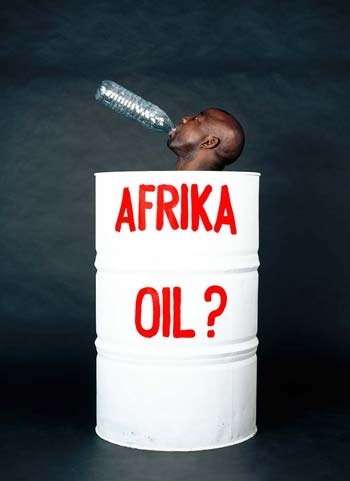Middlebury College Museum of Art Focuses on Contemporary Socio-political African Art

“Environment and Object • Recent African Art”
January 27—April 22, 2012
For immediate release: 12/21/11
For further information contact: Emmie Donadio, Chief Curator, at (802) 443-2240 or donadio@middlebury.edu
Middlebury, VT— This February, responses to urban, natural, and economic environments by contemporary sub-Saharan African artists will be on view in a thought-provoking exhibition at the Middlebury College Museum of Art. From appropriated waste materials turned into site-specific installations and sculptures to eerily compelling photographs of ravaged and degraded environments, Environment and Object • Recent African Art will include works of art that scrutinize man-made environmental disasters, natural resource problems, deforestation, and other ecological issues.
Other artists in the show take a less directly political approach regarding their environments, using found objects and abandoned junk to create both visually compelling and intellectually challenging art works. Opening January 27, the exhibition will present the work of Africans living and working around the globe, including internationally recognized artists Yinka Shonibare, El Anatsui, Viyé Diba, Barthélémy Toguo, and Zwelethu Mthethwa, as well as emerging artists gaining a reputation outside of Africa, such as Bright Ugochukwu Eke, Lara Baladi, and Nnenna Okore.
“Many of the artists on view incorporate found objects into their work, whether to address ecological and economic conditions or simply to reflect the nature of the world they live in” said co-curator Lisa Aronson, Associate Professor of Art History at Skidmore College. “El Anatsui and Nnenna Okore employ materials taken from urban and rural environments to create expressive and provocative wall hangings and sculptures. Other artists in the exhibition work in traditional media like paint and photography to create meditations on natural resource management or industrial pollution. Yet, all decisively reject romanticized perceptions of Africa, while offering a broader view of contemporary Africa and conditions which concern it.”
Bright Ugochukwu Eke, a Nigerian artist working frequently in the U.S., often explores humans’ negative impact on the environment. When Environment and Object debuted, at the Frances Young Tang Teaching Museum at Skidmore College where it was conceived and curated, Eke was an artist-in-residence working with four Skidmore studio art majors to create a site-specific installation incorporating plastic water and soda bottles. Known for his elegant architectural works, Eke’s installations are often made through the accumulation of hundreds of identical, discarded objects, in order to focus attention on the “earth-human connection.” Viyé Diba of Senegal, who creates painting, sculpture, and mixed media installations incorporating objects and photographs, was also an artist-in-residence at the Tang, and he will spend a week on the Middlebury College campus in February while his piece is installed.
In addition to artists employing found objects, a number of artists in the exhibition comment on political and environmental situations on the continent through photographic works. Calling attention to policies that fail to protect the land or its inhabitants, former AP photographer George Osodi captures oil field explosions in Nigeria over the past decade, documenting the appalling destruction of landscapes, livelihoods, and ecosystems caused by the oil industry. Garth Meyer creates luscious silver gelatin prints that belie the savage deforestation in South Africa and across the continent. Barthélémy Toguo also responds to deforestation in his work “Stupid African President 2.” The work depicts a man balancing a chainsaw on his head, a cheap, portable, easy-to-operate tool which has allowed loggers access to jungle forest tracts previously inaccessible to vehicles or heavy machinery.
“Environment and Object…highlights situations that concern all of us, across many fields and in many places,” says co-curator John Weber, Dayton Director of the Tang Museum. “The fact that the artists creating this work are from Africa is significant, too, and underlines both the global nature of their work and the conditions it engages.”
Environment and Object opens on January 27 and runs through April 22. The exhibition is curated by Lisa Aronson, Associate Professor of Art History at Skidmore, who specializes in African art history, and John Weber, Dayton Director of the Tang. Aronson and Weber will give a joint illustrated lecture title “Environment and Object in Recent African Art: Issues, Artists, and Objects” on Thursday, February 16 at 4:30 p.m. in room 221 of the Mahaney Center for the Art.
The exhibition will be accompanied by an extensive catalogue, published by the Tang and Skidmore, with new essays on a range of topics related to art and the environment that serve as a valuable resource on the current generation of African contemporary artists. The catalogue includes essays by the curators Aronson and Weber, a new interview with art historian Chika Okeke-Agulu of Princeton University, and essays by political scientist Chris Whann of Empire State College, environmental studies professor Karen Kellogg of Skidmore, and socio-cultural anthropologist Mark Auslander of Brandeis University.
Environment and Object • Recent African Art is supported by the Andrew W. Mellon Foundation, the Getty Foundation, the Tadahisa Kuroda Exhibition Fund, the Virginia Gooch Puzak ’44 Faculty Curatorial Endowment, Chief Oskar Ibru ’81 and Chief Mrs. Wanda Swann Ibru ’79, and Friends of the Tang, with additional support from the Henry Luce Foundation and the Creative Thought Fund at Skidmore. At Middlebury the exhibition is supported by the Christian A. Johnson Memorial Fund and the Friends of the Art Museum.
